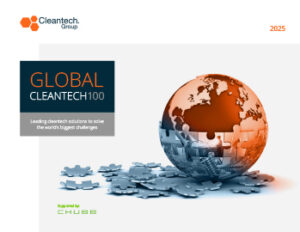From Buzz to Impact: AI’s Role in Accelerating the Clean Economy
Artificial intelligence (AI) has become a frequent topic of discussion, but does it truly deliver added value? And if so, how can AI accelerate the transition to a clean economy?
Cleantech Group and Clean AI Initiative teamed up to produce a new report titled Cleaning Up With AI, which explores the application areas and potential sustainability impact of AI on cleantech innovation across five industry verticals.
The scope of AI-enabled cleantech innovators includes companies that utilize AI as a core differentiator and integral part of their primary business model or as a critical component of their service offering/product that is materially advanced by the use of AI.
Cleantech Group and CleanAI teamed up to produce a new report, Cleaning Up With AI, covering nearly $30B of risk capital invested across five industry verticals. Nick Parker, Founder of CleanAI, and Nino Lazariia, Consultant at Cleantech Group, discuss this exciting topic.
According to the study, the global demand for AI-enabled cleantech solutions is predicted to steadily rise. Over the past six years, such solutions have accounted for 12% of investments and deals across all cleantech-related contracts, amounting to nearly $30B of risk capital invested. Looking ahead, an estimated $138B will be required in the next six years to double the current growth.

Key Trends in the Clean AI Ecosystem
- AI holds significant potential to enable a clean economy in areas like materials creation and discovery, forecasting, and advanced modeling. Examples across cleantech industries include:
- Agriculture & Food: AI used for discovering novel ingredients and protein formulations, such as finding alternatives to chemical pesticides and fertilizers (e.g., Boost Biomes, NotCo, Enko Chem).
- Energy & Power: AI aids in simulating fusion reactors, thereby accelerating the timeline and accuracy of physical experiments (e.g., First Light).
- Materials & Chemicals: AI assists in chemicals and catalyst discovery, predicting new and diverse sets of reactions and molecules or identifying catalyst alternatives (e.g., Chemify, EnginZyme, H2U).
- Resources & Environment: AI is employed for climate risk modeling, predicting vulnerabilities from future extreme weather events, and helping prepare for them (e.g., Rhizome).
- Transportation & Logistics: AI enables ultra-fast charging by creating unique charging protocols to protect EV batteries and optimize performance (e.g., Fermata Energy).
- Agriculture & Food: AI used for discovering novel ingredients and protein formulations, such as finding alternatives to chemical pesticides and fertilizers (e.g., Boost Biomes, NotCo, Enko Chem).
- Of the nearly $30B of risk capital invested in the last six years, 70% has been in Seed and Series A rounds. The early stage of the majority of innovators presents an opportunity for involvement from the outset observing the development from R&D stage to commercialization.
- Differentiated business models and data strategies will be key to value creation and impact. Customers are not buying into the AI buzz but rather are seeking specific use cases applied to their solutions or challenges.
- C-Suite and operational champions with the domain expertise and willingness to test new systems will be critical to scaling to widespread market adoption. Other challenges include:
- Sparce or sensitive data for which data sharing standards should be developed.
- Skills shortages which can be addressed by developing academic collaborations and upskilling.
- Distinguishing business applications and the impact of Clean AI from the wider public fixation on Generative AI, requiring clearly defined and articulated differentiation.
- Sparce or sensitive data for which data sharing standards should be developed.
- Connecting a fragmented ecosystem and increasing public policy support will further accelerate AI’s positive impact on the clean economy. Examples include collaborations between incumbents like Nvidia, Google, and IBM with AI-enabled cleantech innovators to develop new solutions, as well as government investments in AI research and development across North America and Europe.
Supply and Demand for AI-enabled Cleantech Opportunities
In the realm of addressing climate challenges, AI-enabled cleantech solutions are proving their value. These solutions tackle issues such as escalating input costs, surging energy demands, and the imperative to reduce waste and emissions across diverse industries. Through the integration of artificial intelligence, these solutions drive operational efficiency, optimize energy assets, enable predictive maintenance, enhance energy utilization, detect leaks, predict hazards, and much more.
Cleantech innovators are at the forefront of this transformation, integrating AI capabilities across various facets of their operations. From monitoring and analyzing data to optimizing processes, forecasting demand or autonomously allocating resources, they are harnessing AI’s power to deliver optimal solutions.
Universities, research institutes, and incubators worldwide are vital sources of innovation, nurturing the growth of these innovators. Several noteworthy examples include:
- DeepSense, situated at Dalhousie University, focuses on advancing AI research and innovation for the ocean economy. By fostering industry-academic partnerships, DeepSense aims to propel the ocean economy forward through applied research in artificial intelligence, machine learning, and big data.
- Novarium, an innovation campus located in Quebec, is dedicated to advancing the blue economy using technology and AI. With a vision to catalyze the ‘blue revolution’ on a regional and global scale, Novarium employs AI to create a more intelligent and sustainable ocean economy.
- The AI-CLIMATE Institute, based at the University of Minnesota, leverages AI to promote sustainability in agriculture and forestry. As one of the seven new NSF- and NIFA-funded AI Institutes, it aims to facilitate collaborative research in artificial intelligence nationwide.
- The NVIDIA AI Technology Centre in India is focused on advancing AI research in sectors such as agriculture and smart cities. Topics covered will include increasing crop yield and supporting safer transportation systems and better ways of managing traffic.
Looking Ahead
Innovators should choose one of two potential scenarios:
- Path to IPO: Like most current Clean AI companies, future entrants will use targeted, narrow AI models optimized for their applications, requiring custom development of AI tools along with AI-enabled products and services. Therefore, the majority of the investment will not be for AI development itself but for the development and deployment of AI-enabled products and services.
- Path to M&A: Ongoing progress in more general AI tools, such as those from incumbents like OpenAI, Google, Microsoft, and IBM, may produce broadly capable tools that could be applied to Clean AI, using approaches such as prompt engineering and fine tuning. If this becomes feasible, it could reduce the need for, or value in, more targeted models, potentially leading to acquisitions. This would lower the barrier for developing AI-enabled products and services for new entrants while eroding the advantage of current companies’ existing technologies.
Understanding the market impact and the scope of use cases will help organizations maximize AI potential.
To learn more about Clean AI, register for our complimentary webinar on March 26th at 11:00 EST: Cleaning Up With AI: AI Impact on Cleantech Innovation.



